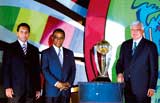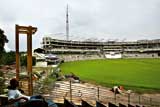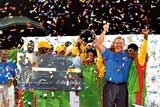Rally round the West Indies
The West Indies' preparations for the World Cup and whether it will see a renaissance of cricket in the region
Rahul Bhattacharya
11-Mar-2007
|
|

|
The photograph - a friend's father, a Bajan working-class immigrant in Birmingham, a bus driver with the West Midlands Transport Board, fitted in tuxedo, top hat, gloves, and cane, and a face of uncontained pride. It was the happiest day of his life. It was not from his wedding, but the day after the Lord's victory. He explained to his son: "For me, son, the empire collapse right there; not Churchill or Wellington could bring it back."
But the extravagance, a £2.10 rental for the tuxedo - he drove the bus wearing it - was costly in more ways than one. It provoked the wife to walk out for a week, and later away altogether. The son, born in England, of a different circumstance, a different generation, could not empathise with his father's recklessness. Indeed, it so disturbed him that he broke off ties.
Beckles presents this as the most vivid illustration of West Indian - not West Indian cricket's, West Indian - movement from colonisation to nationhood. If the beauty of the story, its emotional resonance, derives from the connect on the one hand, the disconnect on the other makes it apposite.
Because, take a stroll today about the "savannahs" of Trinidad and you will find one game of cricket to four of football: the Soca Warriors, Trinidad and Tobago's football team, made it to Germany last year, a nation of 1.3 million in a competition distilled from 200 countries, where in cricket, the West Indies of 6.5 million are now third to last in a pool of 10. And in Jamaica, home to the great George Headley and Courtney Walsh, their best known sportsperson is the world-champion sprinter Asafa Powell. Two months ago a premier first-class match was not on radio, so barely anybody in Kingston even knew it was being played in the city. And so on.
Once the foremost cultural, political, and social expression across the Caribbean, cricket is now no longer even the main sport. A kind of meaning has been lost. So when the West Indies hosts the biggest event in cricket, the biggest ever event of any kind in the region's history, its function goes beyond being a showpiece. It must have to see whether the meaning can be recovered, whether a new meaning can be found.
***
It's been 10 years since the West Indies Cricket Board (WICB) conceived the idea, about nine since the bid was won, and almost six since the incorporation of Cricket World Cup WI 2007 (CWC), the parent company. The CEO is Chris Dehring, an investment banker who had been seconded to set up the commercial arm of the board. Having developed the bid presentation, he was asked to stay on and run the event. From a WICB of "three or four people" in 1997, the CWC now runs on a staff of 80 at its Jamaica headquarters. Counting the organising committees of the different territories, construction crews, volunteer forces, it is a team of about 10,000.
If ever there was a World Cup designed to test Caribbean resources, it is this: the longest yet, the most number of teams yet. Enough craft may be ultimately chartered by the horrendous local airlines to transport visitors, estimated at anywhere between 50,000 and 100,000, but will the luggage make it too? Will the Pakistanis and New Zealanders manage to process their Caricom Special Visas? Will the holiday-making Scandinavians, turned off by the new $100 visa when they did not earlier need one, having moved their millions of dollars of business elsewhere, return the following season?
The matches are to be played across nine republics. And this is the biggest challenge, Dehring will tell you. "How do you coordinate nine countries? First of all how do you select the countries? How do you get them to buy into a process where somebody is going to be in charge - nine individual countries with their own ways of doing things? And throughout the length and breadth of the host agreement you have this very scary clause - scary not because we couldn't accomplish it, but scary because of the different interpretations of it - and that was: world-class standards. Nine countries, nine traditions, nine world-class standards."
The ICC did not specify these standards; CWC created its own. "We brought in some of the world's experts on cricket stadia, technology, broadcast", says Dehring. "We identified 24 areas - security to medical to transportation - and put together a 290-page bid book. Financed by us, created by us and in fact the ICC has now adopted it."
The document was handed out to the countries with the basic message: Want the World Cup? This is what you need. Convince us. "Guided autonomy" was the term. "And we got these immense, immense bid responses, incredible professional documents which actually became the core masterplan."
The very pride involved, let alone anything else, sent governments scurrying to draw up plans. For small to miniscule economies it has meant a massive spend. Not a week goes by without the question being asked in some territory: is it worth it? In a stinging article last year, Edward Seaga, the former Jamaican right-wing Prime Minister, damned the $100 million-plus "squandermania" as an "excellent example of small countries with small resources trying to do what big countries do, on the same lavish scale, in order to show that we can throw a good party too."
But back at the Barbados organising committee headquarters, Stephen Alleyne, its CEO, will counter: "You know, the roads are not going to be dug back up after the World Cup. The upgraded airports, the tourist infrastructure, it will all be standing." He will point out that an estimated 50 years of development were telescoped into the eight years leading up to the Barcelona Olympics; and that in the decade following it tourist receipts increased by 129 per cent to make that city the number one short-stay destination in Europe.
Things have revolved around the World Cup. A casino legislation has been passed in Guyana, for how else would the big new hotel being built alongside the stadium sustain itself beyond the World Cup? A man in Barbados is selling motorbike services for the tournament. Rudy Grant, musician brother of the more famous Eddy, suggests that performing artistes boycott the event till politicians alter piracy laws. Hotels and guesthouses are frantically rushing to completion as you read, homes are being opened up to the bed-and-breakfast scheme. Everyone is eyeing something. Will it be enough?
Akshai Mansingh, an orthopaedic surgeon who heads the West Indies cricket medical panel, and commentates in his spare time, went to India last year with Jampro, jamaica's investment facilitation agency. The idea was to use the cricket to woo non-traditional investors: Bollywood producers to shoot in Jamaica, IT companies to set up near-shore offices, given the proximity and fibre-optic connectivity with the United States. Yet he fears that not enough has been done. Where are the ideas? Why not divert buses going up to the North Coast from Kingston to villages for a traditional Jamaican breakfast? Why not plan informal "curry-goat" matches with a big name and pick-up sides of tourists? Why haven't there been TV adverts selling the region and the tournament during the last season? It could be the difference between a legacy of profit or debt.
|
|

|
All this is definite progress. Yet the region remains divided on the issue. Apart from the opening-ceremony venue at Trelawny on the northern coast of Jamaica, itself a project that has split opinion, the stadiums are "multipurpose" only to the extent of being available for concerts. Sure the upgraded facilities will generate greater revenues from hospitality and events marketing, but with nine spanking Test-ready venues, as opposed to five a decade ago, can each territory be ensured enough international cricket per season? What will become of Bourda in Guyana, and the Antigua Recreation Ground? Will the strict spectator regulations douse the informality, the spontaneity, the intimacy, the very magic of watching cricket in the West Indies?
Even as stadia rush desperately to finish, Dehring is confident that the playing surfaces, about half of them completely virgin, will be the best set of pitches ever. Indeed, some of the work has been exceptional. At Jamaica's Sabina Park, the drainage system has become so sophisticated that even players were stunned when a one-dayer last year commenced after morning rain. And to walk into the Kensington Oval in Barbados, venue for the final, is to marvel at what will be one of the premier cricket centres on the planet when it is complete. It is designed by a British architecture firm, built by an Indian engineering company, with temporary stands set up by a Swiss group.
That is also the problem. The Indian project manager estimates that the same work in India would have been done at 60 per cent of the cost. Everything has to be imported. Like what? "This," he reaches for the nearest object, a door handle. "This has to be imported."
***
"I ehn negotiating ah told them
If they get money we can't control them
A West Indian cricketer must always be broke
Is then he does bowl fast and make pretty stroke"
If they get money we can't control them
A West Indian cricketer must always be broke
Is then he does bowl fast and make pretty stroke"
During talks between the board and the players in the Packer years, the calypsonian Mighty Sparrow had got to the heart of the matter. Leave aside the details of the extraordinarily protracted contracts battle between the players and the board, a fundamental point is that there is no money at all. The WICB is in debt to the tune of $15 million. A small consumer class, and the ICC's restructuring of international tour revenues so that only hosting boards earn have contributed, but it is really maladministration that has seen the board so beggared. Asked to comment on the board chiefs of the past decade, a senior journalist snorts, "One older than the other."
The regional match fees are an embarrassment. The average player earns between $200 and $350 dollars for a four-day match, and about half that for a one-dayer. There are a mere five of each a season. Who'd want to be a cricketer?
Michael Seepersaud, the first, and possibly last, chief cricket development officer of the WICB, quit in 2006 a frustrated man. Promised a modest budget of $2 million annually, he received barely 30 per cent of that. He could not see eye to eye with the management at the Shell Academy in Grenada, which itself shut down due to lack of funding.
A decade ago Richie Richardson, after resigning the West Indies captaincy in embarrassment following the World Cup defeat to Kenya, had asked: "How often is cricket being shown on television in our homes? How much is cricket being promoted? How much money is put into the game by governments and by the business sector? How much support do our cricketers get in terms of coaching jobs in the West Indies?"
The last three questions still remain; and in being too tardy in rectifying the first, West Indies cricket has lost a TV generation, particularly among the black urban youth, weaned on European football, American basketball and athletics. The choice between football and cricket for Viv Richards had been made by his father: "He stated, very simply, that he had never heard the West Indies football team on the radio," wrote Richards in his first autobiography, Hitting Across The Line.
In the schools, says Pat Rousseau, the former board chief, there are no longer enough games periods and games masters, though this varies from territory to territory. So too Franklyn Stephenson, the Barbados allrounder of the 1980s, feels there is not enough play among the kids. Too much structured cricket - age-group tournaments and so on - but not enough play.
Money cannot make or remake a culture, but it can nurture it, and as the Trindadian writer Vaneisa Baksh points out, ideas to raise funds have never been the problem; the problem is the paralysis of the board and the governments and Caricom. Ideas have included channelling airport exit-taxes into a cricket fund, and as Brian Lara suggested recently, fan-membership schemes like those of Barcelona FC. Baksh herself has pushed for the marketing of cricket posters, books, songs, memorabilia, paintings, films, and the institution of cricket museums at stadia - ideas that seek to foster both financial and cultural health. Yet when she quit the World Cup board of directors two years ago, she felt that the ideas were deemed too soft, too "womanly": there wasn't a place for them in the bastion of the conservative male.
|
|

|
King's plan envisages the year-round employment of players and coaches, a modern academy, and the establishment of a new league to supplement the existing territorial tournaments. There is hope in this holistic plan. But where's the money to come from?
As this is being written, the president of the WICB is lobbying heads of governments
at a Caricom summit to institute a Cricket Development Trust Fund. The World Cup -
already entrusted with the responsibility of generating revenue enough to at least
save the board from shutting shop - if it is able to prove the tangible benefits of
cricket to the region, will help swing it.
***
In the 1950s the West Indian quest for independence, and the campaign to establish Frank Worrell as the first black captain of the cricket team (George Headley had led in one Test in 1948) were part of the same political process, inextricable. Modern West Indian cricket, like the modern Caribbean, was born out of a moral and political conviction that rejected black inferiority. Worrell, first among equals in the lineage of West Indies captains, sowed the seeds of excellence. Garfield Sobers reaped the fruits. But a brief apathy set in, before Clive Lloyd and then Vivian Richards administered the domination. Their 18 years was the era where professionalism, ideology, and sporting genius converged at a height and duration rare in sport, and miraculous in the context of this infant archipelago in the bigger world.
Lloyd was of uncompromising ambition, evident from his account as a young player in the later Sobers years: "No thought was given to training schedules...very rarely had catching practice...several players became overweight...team meetings were a shambles...Garry spent a lot of time on the golf course and not enough in the nets, looking after the team..."
So when he got his chance, Lloyd set about instituting discipline and unity. This was one part of the professionalisation; the other was the fight to be paid decently for this excellence. As Worrell before him, who'd refused to make a tour in protest against the pay, so Lloyd and his champions-to-be signed with Kerry Packer, and the team was moulded by the most demanding cricket of their lives, as too the far-sighted appointments of Rudi Webster, the psychologist, and particularly Dennis Waight, the physical trainer.
Lloyd's chief enforcer was also his successor: Richards, batting to destroy, posturing to intimidate, wearing his ideology in the Rastafari colours on his wrist, and his intent in his swagger. As he makes clear in his book, Richards "cannot evade the point that playing cricket is itself a political action"; he believes "very strongly in the black man asserting himself in this world and over the years I have leaned towards many movements that follow this basic cause"; he wants to tell people that "my pride, for the record, is as big as that of any other man".
But the exemplary discipline instilled by Lloyd had already begun to crumble under Richards; and Richards's own ideological power, which had alienated the East Indian community, rang hollow for the generation succeeding him.
Beneath the frontal force had lain complacency. While Australia in the 1980s wrestled at every level to devise schemes to climb to the top, West Indies reckoned it would just continue to happen. It didn't. Decay in the administration; disunity among the players; indifference among the youth; stagnation in the infrastructure; and finally bankruptcy. Devoid of ambition, shorn of ideology, the speed and severity of the descent could be considered as extraordinary as that of the rise, except that it is far easier to destroy than to build.
And this, really, is the great hope of the World Cup. Regeneration. The infusion of desperately needed money; the confidence from hosting a thing so big, and the range of skills learned in executing it; the upgraded infrastructure; the inter-governmental cooperation as seen in a common visa and legislation: the World Cup holds the potential to propel West Indies into alignment with the specific demands of what Beckles identifies as the "third paradigm" of West Indian cricket: the age of globalisation, following those of imperialism and nation-building. And it will put cricket at the top of everyone's mind, cricket in the stadiums, cricket on the telly, cricket in the papers, visitors coming for the cricket, "limes" around the cricket, cricket everywhere for youth to absorb.
The capacity of sport to unite is too easily proclaimed in different lands as unique. Cricket does not merely raise or destroy morale in West Indians. Without cricket there is no "West Indies" - only little competing countries which share a university and a brutal and overlapping past. Cricket reassures them that, together, the greatest excellence can be theirs. It finds them a bond where otherwise there is sea. It is the ultimate validity of strength in unity. And the way they can play it is very beautiful.
Rahul Bhattacharya is the author of Pundits from Pakistan. He is currently based in Guyana.